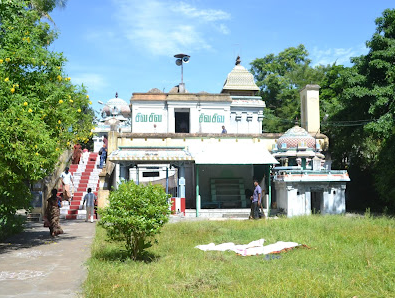In the court of the Devas, Vayu, the God of Wind, and the divine serpent Adisesha both claimed supremacy over their prowess. Adisesha showcased his might by covering the peaks of Mount Meru with his thousand heads. However, Vayu was unable to shake the mountain, which created panic in the world. Yielding to the pleas of the Devas, Adisesha relinquished one peak. Vayu shook this peak free and transported it southward; a small piece fell in this location, according to the sthala purana.
This fallen piece transformed the formerly flat landscape into a small mount, upon which the temple is believed to have been constructed. Lord Shiva manifested here as a Tejolinga as a result of the penance performed by King Bruhadrajan in Krutha Yuga. During Dwapara Yuga, to protect the Devas from the demon Vruddhasura, Lord Shiva transformed all the Devas into bees and advised them to create beehives in the sanctum and worship Him. Consequently, the Lord came to be known as Madhuvaneswarar (with "Madhu" meaning honey in Sanskrit), while the goddess is referred to as Madhuvana Nayaki, and the place is called Madhuvanam. Even today, bees can be found in the vicinity, yet they pose no harm to anyone.
Sthala Puranam :
The temple's legend begins with a battle between Adiseshan and Vayu, during which a portion of Mount Meru was broken off. Vayu carried this piece to the south, and it fell here, forming a mound. Lord Shiva manifested as a swayambhu murti on this mound.
In the Satya Yuga, a celestial being named Brihadrajan worshipped here, and Lord Shiva appeared to him in the radiant form known as Tejolingam or Prakasa Nathar. During the Dwapara Yuga, the Devas faced harassment from the demon Vritrasura. To protect the Devas, Lord Shiva transformed them into bees, granting them refuge in this area, which subsequently became home to a large bee colony. Today, several beehives can still be found in the temple premises, particularly near the Somaskandar and Murugan shrines, but these bees are harmless to devotees.
The dikpalakas, or guardian deities of the four cardinal directions, installed Lingams at this temple: Indra in the east, Yama in the south, Varuna in the west, and Kubera in the north. Additionally, Lingams worshipped by Brahma and Sage Agastya, namely Mahadevar and Agasteeswarar, are enshrined within the prakaram. Indra is believed to have worshipped here to be freed from the brahmahathi dosham incurred by the slaying of Vritrasura.
The name "Nannilam" is relatively recent, signifying either the fertile agricultural land or the high spirituality of the area, linked to the revered Thandavaraya Swamigal. Historically, this location was a forest of Madhu trees, hence named Madhuvanam, leading to the Lord being referred to as Madhuvaneswarar. The temple has also been known by other names, including Brihadpuram, due to Brihadrajan's significance, Devaranyam, where the Devas took refuge from the asura Jalandharan (vanquished by Shiva at nearby Virkudi), and Sundaravani. In the hymns sung by Sundarar, the temple is referred to as Nannilathu Perunkovil (the great temple of Nannilam), with Shiva also called Brihadeeswarar.
The temple is notable for the abhishekam performed with honey for the Shiva Lingam, considered highly auspicious and beneficial for devotees due to its connection to the sthala puranam.
This temple is one of the 78 maadakoil temples constructed by Kochchenga Cholan. Uniquely, the main temple is elevated to nearly a first-floor level, which is unusual for maadakoil temples. The temple structure is believed to date back to the 8th or 9th century. The Shiva Lingam is installed on a square avudai, which is also a rarity in this region.
The arrangement of the Navagraham in the temple is distinct, with all the planets facing Suryan. There are separate shrines dedicated to Sani and Chitragupta as well.
The temple complex also houses the jeeva samadhis of two saints: Thandavaraya Swamigal, the author of "Kaivalaya Navaneetham," a treatise on Advaita philosophy, who taught at this site, and Narayana Swamigal.
Soola Teertham, believed to have been created by Shiva's trident, is significant; bathing here during the month of Masi is considered equivalent to bathing at the Mahamaham tank in Kumbakonam. Additionally, the garbhagriha contains a bronze idol of Bhoga Shakti. According to temple literature, this site was once home to five different sthala vruksham—Vilvam, Kongu, Vengai, Madhavi (Madhu), and Sanbagam—though currently, only the Vilvam tree remains.
Administration History :
The temple is administered by the Hindu Religious and Charitable Endowments Department of the Government of Tamil Nadu. It has undergone various renovations and restorations over the centuries, reflecting its historical and cultural significance. The management of the temple is overseen by a local trust that organizes festivals and rituals. Important events, such as the Maha Kumbhabhishekam, were conducted on significant dates to maintain the sanctity of the temple. Additionally, the temple has a longstanding tradition of community involvement in its administration and upkeep.
